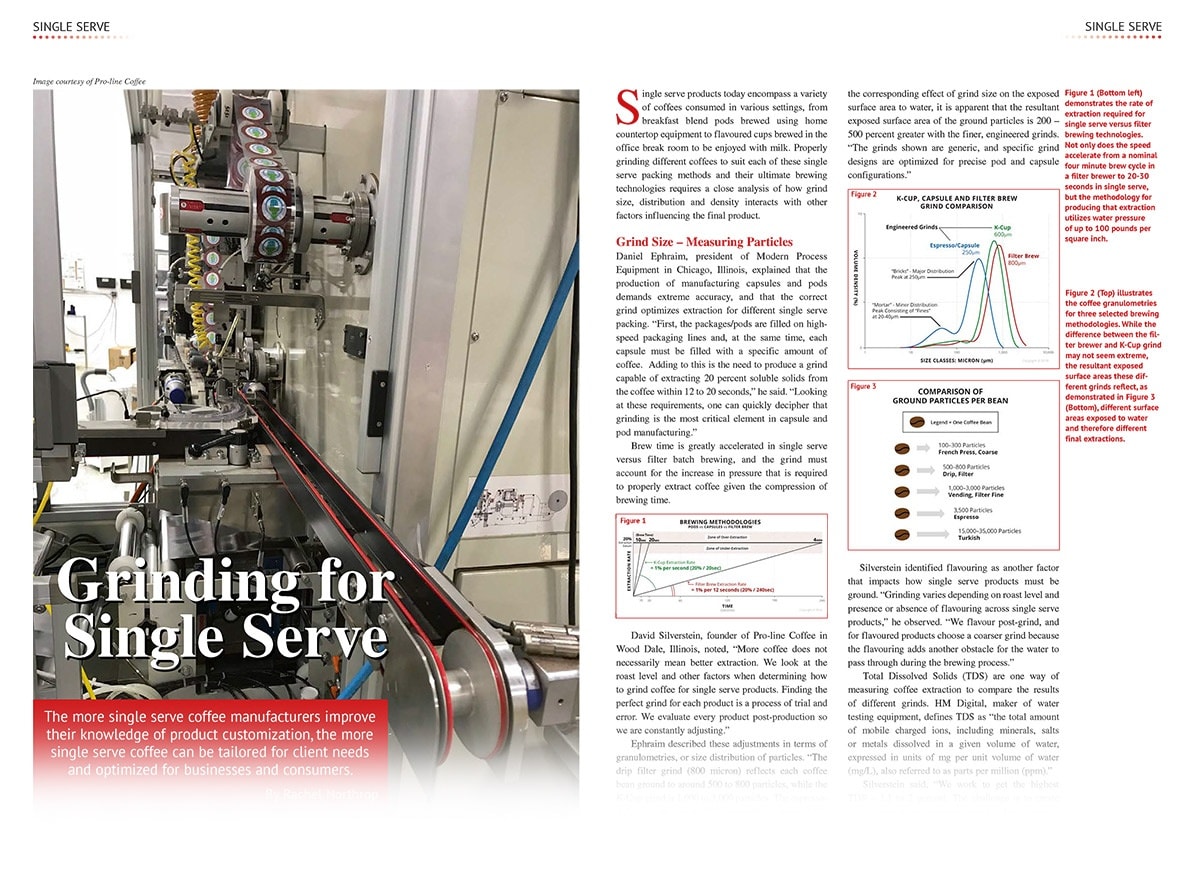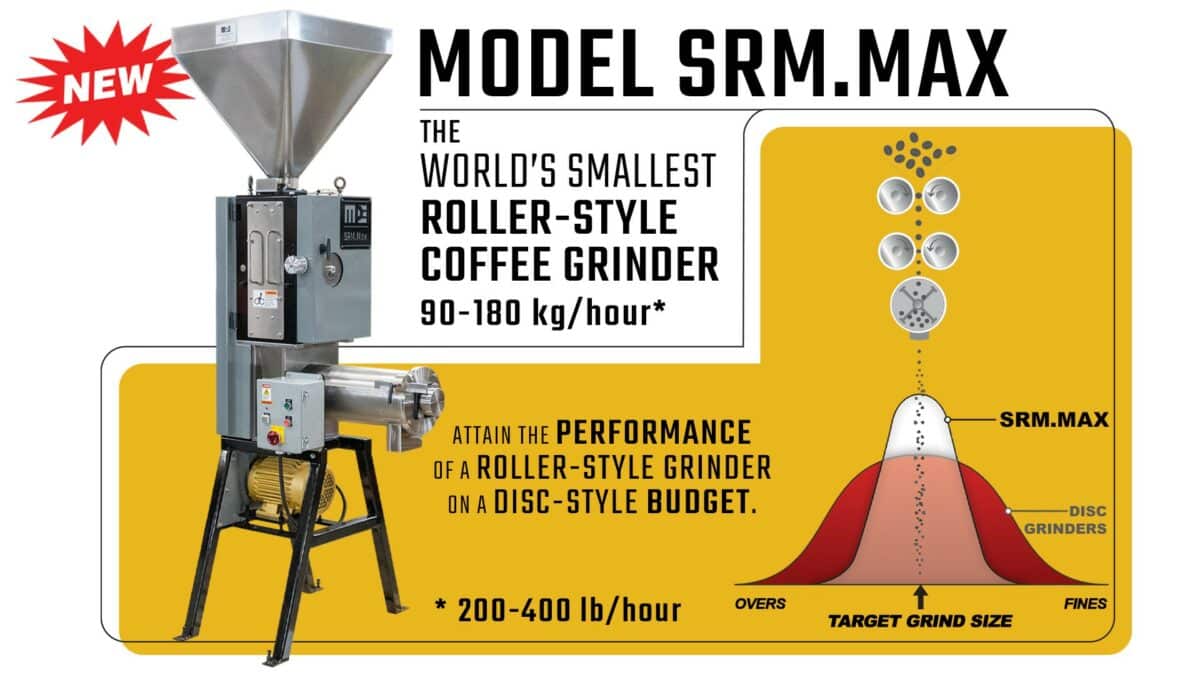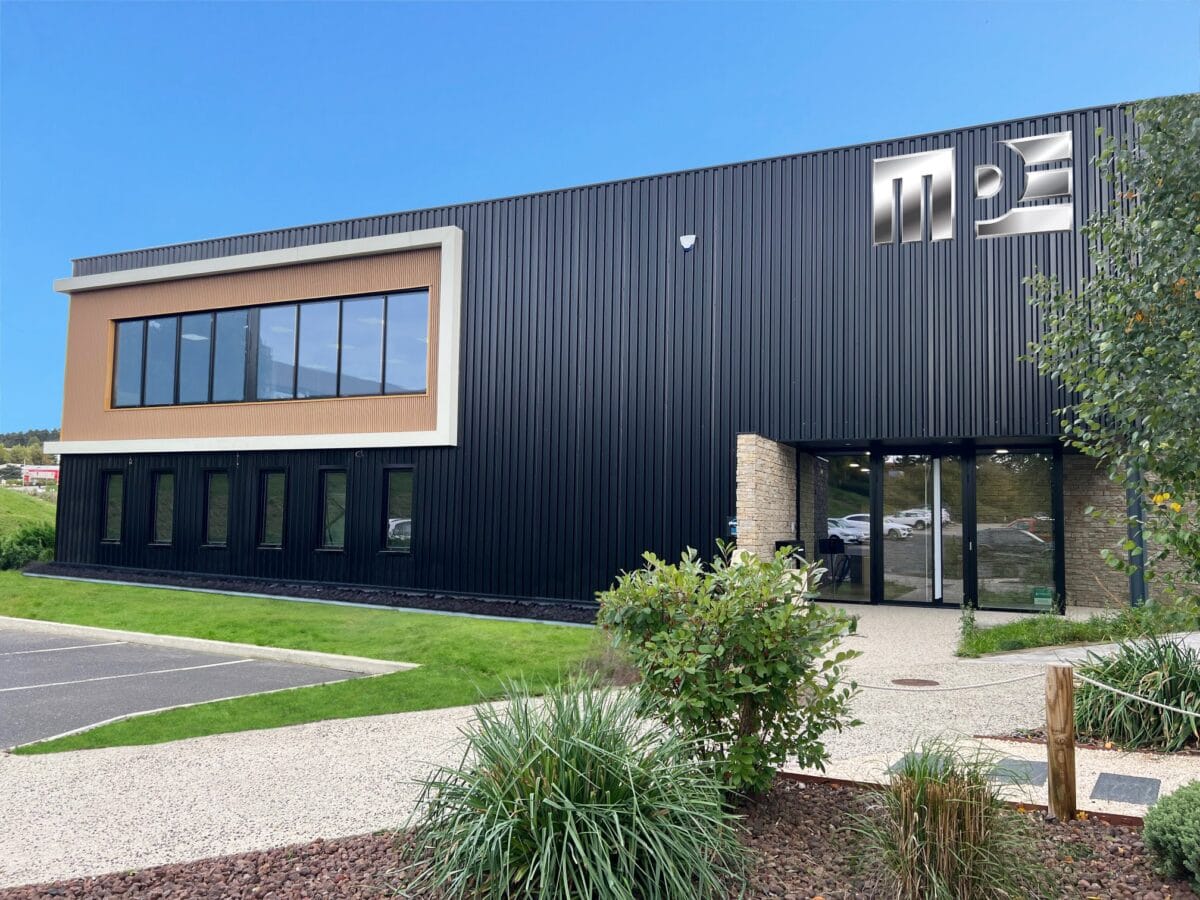The more single serve coffee manufacturers improve their knowledge of product customization, the more single serve coffee can be tailored for client needs and optimized for businesses and consumers.
By Rachel Northrop
(All graphs courtesy of Modern Process Equipment)
This article appeared in the March 2018 issue of the Tea & Coffee Trade Journal.
Single serve products today encompass a variety of coffees consumed in various settings, from breakfast blend pods brewed using home countertop equipment to flavoured cups brewed in the office break room to be enjoyed with milk. Properly grinding different coffees to suit each of these single serve packing methods and their ultimate brewing technologies requires a close analysis of how grind size, distribution and density interacts with other factors influencing the final product.
Grind Size – Measuring Particles
Daniel Ephraim, president of Modern Process Equipment in Chicago, Illinois, explained that the production of manufacturing capsules and pods demands extreme accuracy, and that the correct grind optimizes extraction for different single serve packing. “First, the packages/pods are filled on highspeed packaging lines and, at the same time, each capsule must be filled with a specific amount of coffee. Adding to this is the need to produce a grind capable of extracting 20 percent soluble solids from the coffee within 12 to 20 seconds,” he said. “Looking at these requirements, one can quickly decipher that grinding is the most critical element in capsule and pod manufacturing.”
Brew time is greatly accelerated in single serve versus filter batch brewing, and the grind must account for the increase in pressure that is required to properly extract coffee given the compression of brewing time.
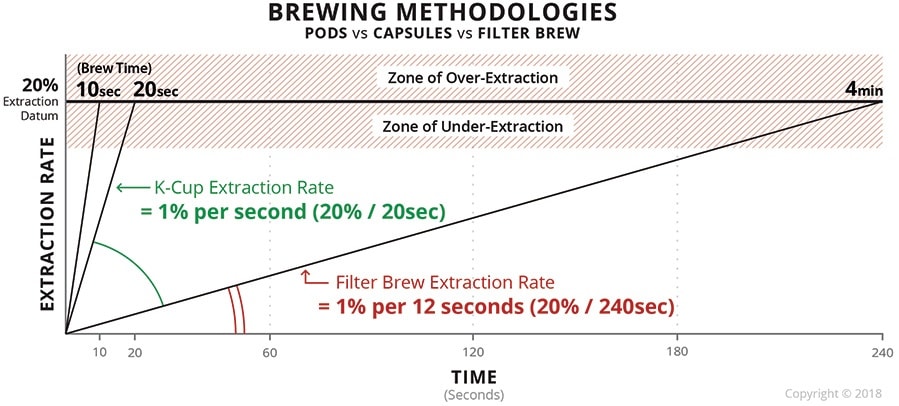
David Silverstein, founder of Pro-line Coffee in Wood Dale, Illinois, noted, “More coffee does not necessarily mean better extraction. We look at the roast level and other factors when determining how to grind coffee for single serve products. Finding the perfect grind for each product is a process of trial and error. We evaluate every product post-production so we are constantly adjusting.”
Ephraim described these adjustments in terms of granulometries, or size distribution of particles. “The drip filter grind (800 micron) reflects each coffee bean ground to around 500 to 800 particles, while the K-Cup grind is 1,000 to 3,000 particles. The espressostyle capsule grind (250 microns) is about 3,500 particles per coffee bean.” He said that if one observes the corresponding effect of grind size on the exposed surface area to water, it is apparent that the resultant exposed surface area of the ground particles is 200 – 500 percent greater with the finer, engineered grinds. “The grinds shown are generic, and specific grind designs are optimized for precise pod and capsule configurations.”
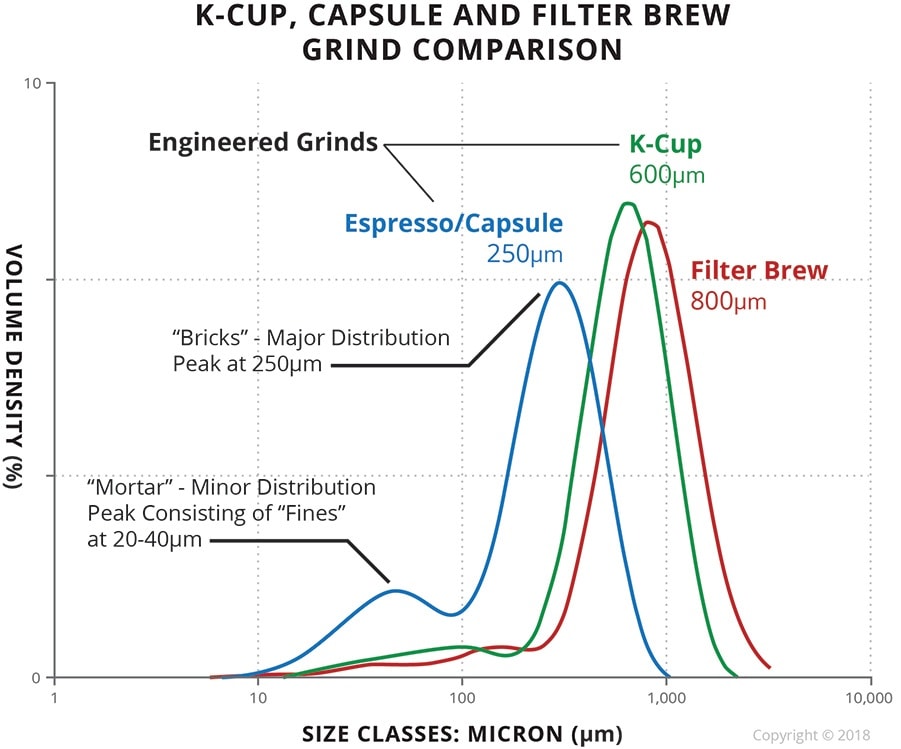
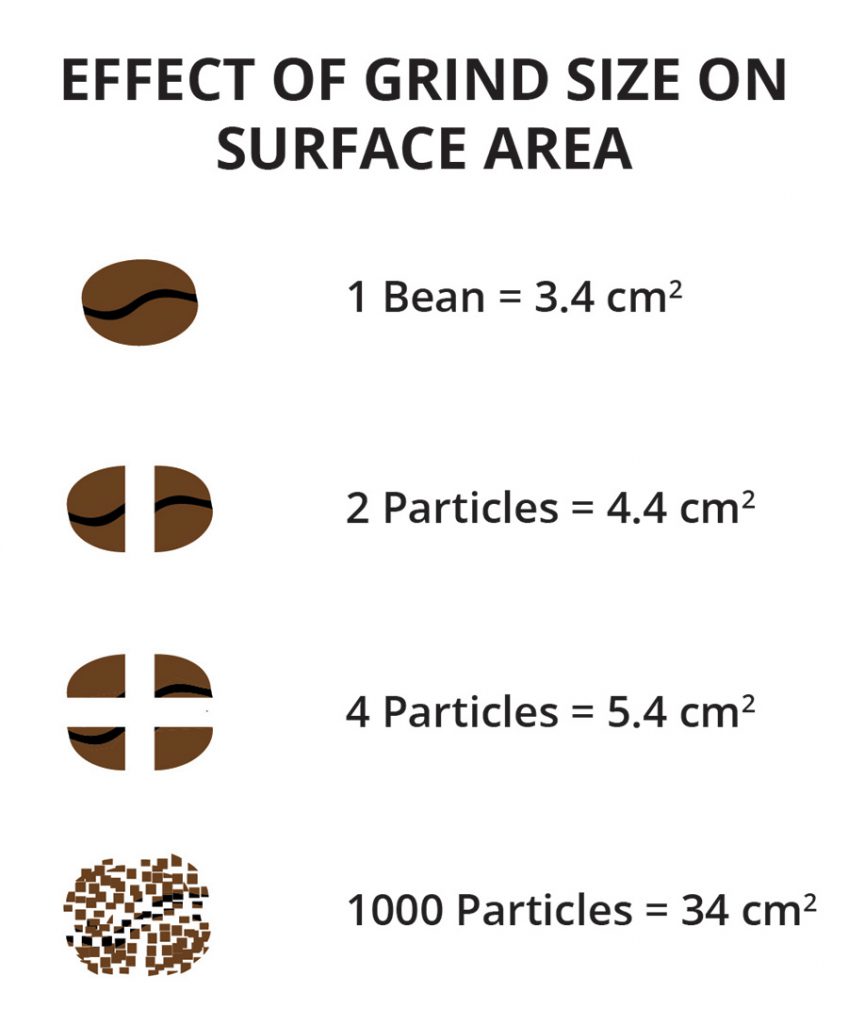
Silverstein identified flavouring as another factor that impacts how single serve products must be ground. “Grinding varies depending on roast level and presence or absence of flavouring across single serve products,” he observed. “We flavour post-grind, and for flavoured products choose a coarser grind because the flavouring adds another obstacle for the water to pass through during the brewing process.”
Total Dissolved Solids (TDS) are one way of measuring coffee extraction to compare the results of different grinds. HM Digital, maker of water testing equipment, defines TDS as “the total amount of mobile charged ions, including minerals, salts or metals dissolved in a given volume of water, expressed in units of mg per unit volume of water (mg/L), also referred to as parts per million (ppm).”
Silverstein said, “We work to get the highest TDS – 1.1 to 2 percent. The challenge is to create a great cup in an imperfect system.” The system is imperfect because beans are not identical. This lack of uniformity creates a challenge in grinding coffees desired to taste the same in each serving of a single serve product.
Densification and Particle Distribution
Particle size of ground coffee is crucial to developing single serve products, and equally as important is the density of how those particles are packed in the portioned container. Modern Process Equipment uses both bimodal grinding and Vortex densification. “Bimodal grind distribution for espresso grinding, which is illustrated in Figure 2, has a double effect,” explained Ephraim. “First, the ‘bricks’ (250 micron particles) provide the correct flow through the cake. Second, the ‘mortar’ (20-40 micron particles) provides the extraction of a large amount of soluble and emulsified material.”
This combination of ‘bricks and mortar’ gives the distinctive taste profile associated with a great espresso. The fine “mortar” grinds of a single serve espresso product produce the effect of foamy crema that occurs with shots pulled on a manual or automatic espresso machine.
Pro-line Coffee makes use of bimodal grinding technologies for their range of products. “We primarily use a two-stage roller grinder,” said Silverstein. “At Pro-line we consider ourselves roasters, but with single serve we have to do the work a barista would do.” While a barista can control the rate of water flow and pressure with each shot, the roaster, grinder and barista are all contained in the packaged single serve unit. The grind distribution must anticipate the brew method, almost like a pre-dosed and prepacked portafilter ready for a barista, but in this case the barista is a pre-programmed machine. Therefore, single serve products must calculate grind size and final density in their packaging more carefully than any other product, since there is no opportunity to make any final tweaks once the product is sealed.
Vortex densification allows for modulation of packing density. “Vortex densification,” said Ephraim, “is the ability for coffee to be more or less ‘fluffy’. This is the technique related to packing a desired quantity of coffee into a given amount of space, which is in this case a pod or capsule, as shown in Figure 4. While ‘fluffy’ is not a technical term, it provides the concept of coffee taking up more or less space in order to fit into a package.”
According to Ephraim, grinding for speed of packing lines is another important consideration for single serve products. “Coffee density is critical in single serve manufacturing because packing requirements can be as high as 1,200 individual capsules per minute with near 100 percent fill accuracy required.”
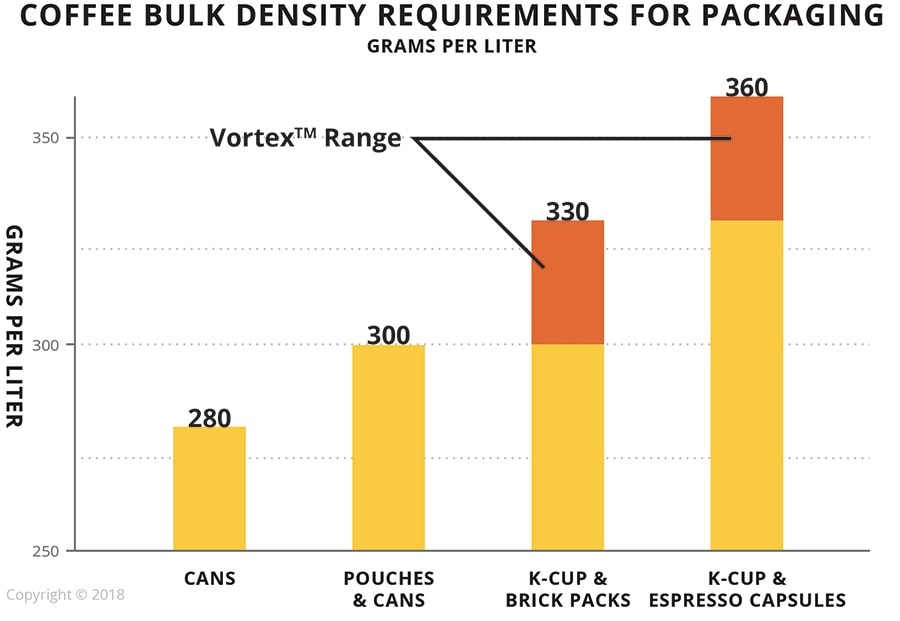
Keeping pace with the flow of the manufacturing process is what makes single serve products tricky, Ephraim reports. “This densification challenge is twofold. The first challenge is consistency. The coffee must maintain a particular density level, consistently, without change throughout a production run. The second is density. The density should be at a significant (high) level as to allow it to fill into the prescribed space of the packaging container (capsule) on a highspeed basis. For instance, if the coffee barely makes it into the cup or capsule, there will be “leakers,” as well as inconsistent brewing performance. This is critical when trying to fit 6-8 grams into an espresso capsule or 10-14 grams into a K-Cup at the rate of 1,200 pods/capsules per minute.”
Customized Design
Single serve products are attractive to many clients for their private labelling possibilities and the chance to customize products. Pro-line’s Silverstein shared that the more products the company experiments with by trying combinations of blends, roast levels, flavourings, and packing modes, the more experience they develop in which combinations yield the best results. “We see what’s successful so that we can confidently make recommendations for private label clients, as each client has different consulting needs.” Grinding allows for further customization, differentiating between a single serve product that delivers an espresso beverage versus a filter beverage, just by adjusting particle size, count, and the densification of final packing.
Single serve’s popularity fluctuates in different settings, but the more that experts in single serve coffee product manufacturing hone their knowledge of product customization, the more single serve can be tailored for client needs and deliver optimized products to businesses and consumers.
Rachel Northrop has been covering coffee for T&CTJ since 2012, while she lived in Latin America’s coffee lands writing When Coffee Speaks. She is based in Brooklyn, NY. She may be reached at [email protected].

